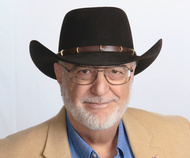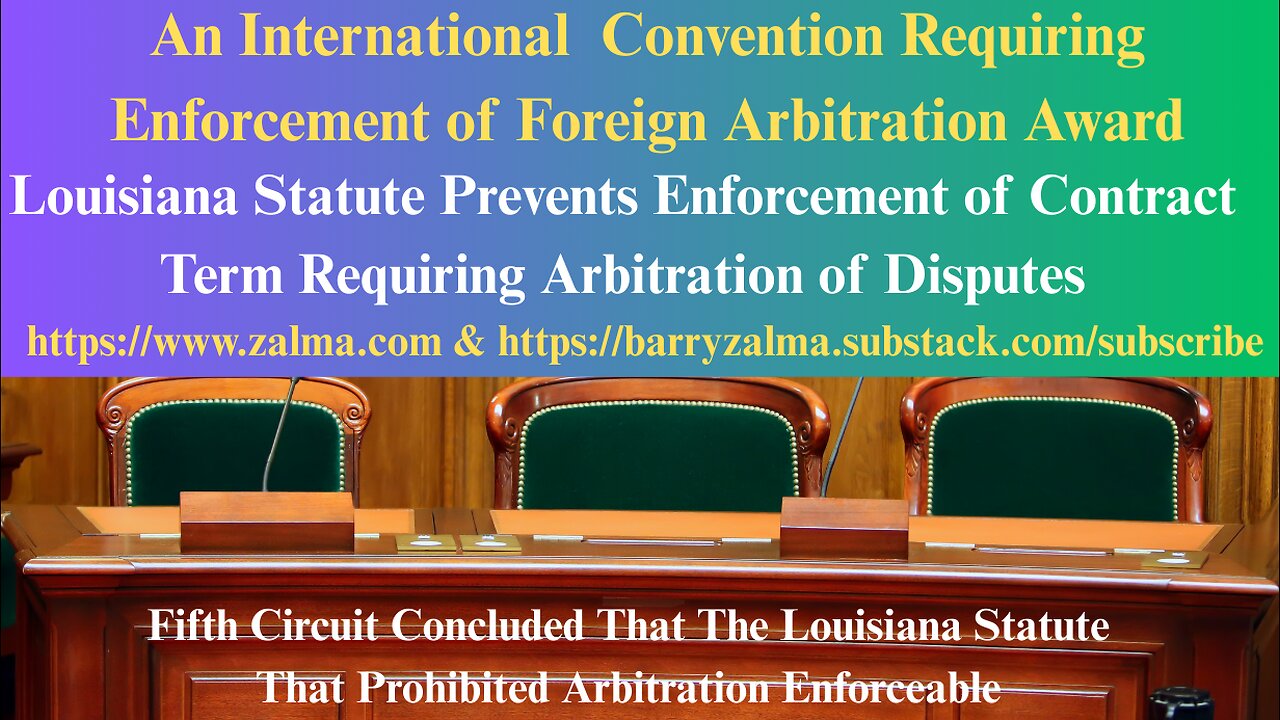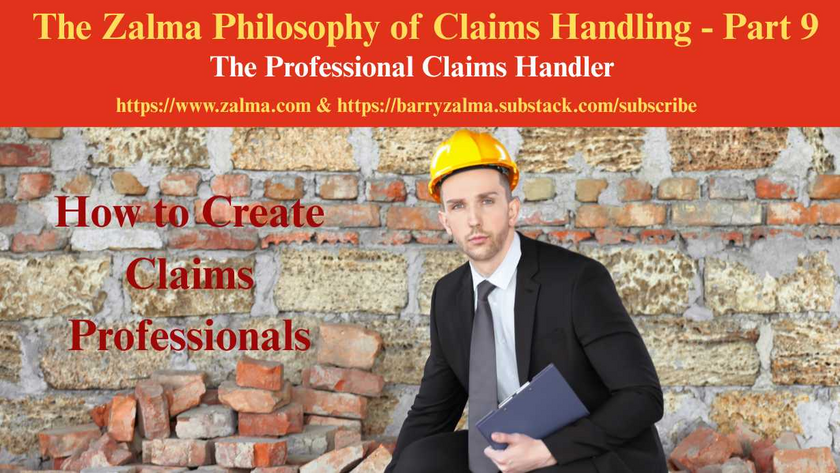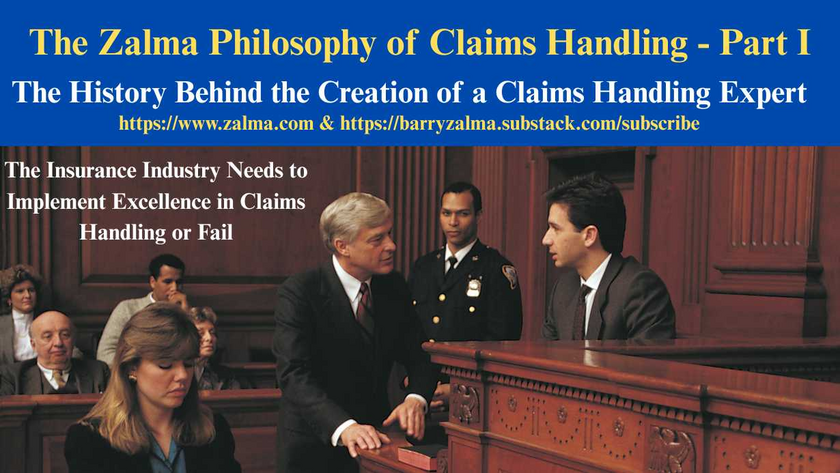
Bad Faith & Damages & The Tort of Bad Faith
Barry Zalma
Read the full article at https://lnkd.in/gryqi8qY and see the full video at https://lnkd.in/gw5YTy-b and at https://lnkd.in/g6YGD7-h and https://zalma.com/blog plus more than 4200 posts.
See the full video at https://rumble.com/v16z3tv-bad-faith-and-damages.html and at
In 1958 the California Supreme Court, with the best of intentions, changed centuries of contract law in Comunale v. Traders & General Insurance Company, 50 Cal. 2d 654, 328 P.2d 198 (Cal. 07/22/1958) and made an insurer’s breach of contract, under particularly egregious circumstances, a tort and allowed damages more than those allowed under contract common law.
Finding that there is an implied covenant of good faith and fair dealing in every contract that neither party will do anything which will injure the right of the other to receive the benefits of the agreement the court concluded that the principle was applicable to policies of insurance. The implied obligation of good faith and fair dealing requires the insurer to settle in an appropriate case even if the express terms of the policy do not impose such a duty.
The Comunales were treated badly. The insurer failed to consider the interests of its insureds and by so doing – by failing to accept a reasonable settlement offer – violated the duty of good faith owed to the Comunales and allowed them, for the first time in a breach of an insurance contract case, to recover tort damages.
The tort of bad faith (created without precedent out of the good intentions of the court) was expanded, as time went by and insurers were found to be liable for various types of tort damages including punitive damages. The first cases finding a tort of bad faith dealt with third party liability policies until 1972 when the California Supreme Court decided Gruenberg v. Aetna Insurance Company, Civ. 38919, 103 Cal.Rptr. 887, 27 Cal.App.3d 616 (1972) applying the tort of bad faith to first party property claims.
State legislatures have enacted Unfair Claim Settlement Acts to legislate what the Communale court created. Those who have adopted all, parts, or expanded upon, the National Association of Insurance Commissioners (NAIC) model Unfair Claims Settlement Practices statute include:
Alaska
Arizona
Arkansas
California
Colorado
Connecticut
Delaware
Florida
Georgia
Hawaii
Idaho
Illinois
Indiana
Kansas
Kentucky
Louisiana
Maine
Maryland
Massachusetts
Michigan
Minnesota
Missouri
Montana
Nebraska
New Hampshire
New Jersey
New Mexico
New York
North Carolina
North Dakota
Northern Marianas
Ohio
Oregon
Pennsylvania
Puerto Rico
Rhode Island
South Carolina
South Dakota
Tennessee
Texas
Utah
Vermont
Virginia
Washington
West Virginia
Wisconsin
Wyoming
The tort was adopted by almost every state of the United States, either by court decision, legislation or both, and the business of insurance and insurance claims handling was never the same again.
Punitive damages were assessed against insurance companies in gigantic amounts with juries and courts awarding punitive damages more than 100 times greater than the amount of compensatory damages for breach of the insurance contract.
After a few decades of abuse of the tort of bad faith by insureds and plaintiffs’ or policyholders’ lawyers, recognizing the impact of the law of unintended consequences, the U.S. Supreme Court, in State Farm Mut. Auto. Ins. Co. v. Campbell, 538 U.S. 408, 416 (2003) found it inappropriate to assess punitive damages for more than ten times compensatory damages and that in most cases punitive damages should never be more than one time the compensatory damages.
The National Association of Insurance Commissioners (NAIC) also created an Unfair Property/Casualty Claims Settlement Practices Model Regulation that has been adopted in whole, in part, or have expanded upon the Regulation in the following states:
Florida
Kansas
Kentucky
Missouri
Nebraska
Nevada
New Jersey
New York
Ohio
Oklahoma
Oregon
Pennsylvania
Rhode Island
Utah
Vermont
Virginia
Washington
West Virginia.
In addition, California, and other states, have created their own set of Unfair Claims Settlement Practices Regulations. Whether state created or based on the NAIC model regulation, the state’s Regulations result in the micro-managing of claims handling and set minimum standards of claims handling that plaintiffs can use to create a bad faith presumption if the insurer did not meet the allegedly minimum standards. The Regulations do not deal with the fact that almost every insurance claim is unique and is like a square peg trying to be fit into a round hold.
Since all insurance claims are unique the claims handling of an individual claim may not fit within the requirements of the Fair Claims Settlement Practices Regulations, plaintiffs’ lawyers, invariably seek tort and punitive damages because of the claimed failure to fulfill the minimum standards. The bad faith suits, thereafter, attempt to hold insurers hostage when a claim is rejected – even if the rejection was proper and in accordance with the terms and conditions of the policy.
The attempt to help consumers get their claims paid promptly was another victim of the law of unintended consequences and resulted in encouraging litigation rather than the fair settlement of claims providing the insured the benefits promised by the policy and nothing more than the benefits promised by the insurer.
The tort of bad faith resulted in thousands of law suits seeking tort damages. Hundreds of judgments were entered against insurers for multiple millions of dollars. Thousands of suits against insurers were settled for amounts in multiples of policy limits for fear of becoming the victim of a run-away jury and punitive damages.
The good deed created by the California Supreme Court in Comunale became a nightmare for insurers who could not convince trial judges and appellate justices, that the law of unintended consequences had struck.
For example, the following are just a few bad faith verdicts drawn from news reports:
$568,000 to Woman in Case against Progressive Select Insurance
$130 Million to Homeowners Underpaid by Farmers Insurance
$20 Million Civil Verdict Overturned: Attention to Anyone Being Defended by an Insurance Company for a Car Accident or Liability Claim
$13 Million in Insurance Payouts Required for Dropping Clients
$233,000 for insurance bad faith estimates for glass repair
Uninsured Patients to Receive 35% Refund for Overpriced Medical Bills at Scripps Health
Walgreens Pays Undisclosed Amount for Dispensing Wrong Medication Leading to Miscarriage
$1 Million Settlement by Allstate Insurance for Failure to Pay Claim
New Jersey Woman Receives $50K Verdict against Allstate Insurance
Life Insurance Company Hit for $39 Million for Failure to Pay
$14 Million Punitive Damage Ordered by Jury for Insurance Company’s Refusal to Pay Benefits
State Farm to Pay $2.5 Million to Couple for Denying Katrina Claim
$250,000 for Flooding Deaths
$20 million verdict against Allstate Insurance.
Bad faith judgments including both compensatory, contract damages, tort damages and punitive damages continue, only held back slightly by the Supreme Court decision in State Farm v. Campbell. The law of unintended consequences continues to wreak havoc on the insurance industry although recent appellate decisions have provided insurers with defenses that make it more difficult for policyholders to succeed in pursuing tort and punitive damages when the insurer’s decision to refuse payment was fairly debatable or there was a reasonable genuine dispute between the insured and the insurer.
ZALMA OPINION
The tort of bad faith proves the concept that the road to Hell is paved with good intentions. The cure of bad faith conduct by insurers led to an abuse of the business of insurance by fraudsters, insureds and lawyers who got rich off tort damages including punitive damages.
(c) 2022 Barry Zalma & ClaimSchool, Inc.
Barry Zalma, Esq., CFE, now limits his practice to service as an insurance consultant specializing in insurance coverage, insurance claims handling, insurance bad faith and insurance fraud almost equally for insurers and policyholders. He practiced law in California for more than 44 years as an insurance coverage and claims handling lawyer and more than 54 years in the insurance business. He is available at http://www.zalma.com and [email protected].
Subscribe to Zalma on Insurance at locals.com https://zalmaoninsurance.local.com/subscribe.
Subscribe to Excellence in Claims Handling at https://barryzalma.substack.com/welcome.
Write to Mr. Zalma at [email protected]; http://www.zalma.com; http://zalma.com/blog; daily articles are published at https://zalma.substack.com.
Go to the podcast Zalma On Insurance at https://anchor.fm/barry-zalma; Follow Mr. Zalma on Twitter at https://twitter.com/bzalma; Go to Barry Zalma videos at Rumble.com at https://rumble.com/c/c-262921; Go to Barry Zalma on YouTube- https://www.youtube.com/channel/UCysiZklEtxZsSF9DfC0Expg; Go to the Insurance Claims Library – https://zalma.com/blog/insurance-claims-library/
Detail Charging Defendant for Fraud is Sufficient
Post 5242
Read the full article at https://lnkd.in/g_HVw36q, see the video at https://lnkd.in/gpBd-XTg and at https://lnkd.in/gzCnBjgQ and at https://zalma.com/blog plus more than 5200 posts.
Charges that Advises the Defendant of the Crime Cannot be Set Aside
In United States Of America v. Lourdes Navarro, AKA Lulu, No. 25-661, United States Court of Appeals, Ninth Circuit (December 4, 2025) Lourdes Navarro appealed the district court’s denial of her motion to dismiss the indictment and enter final judgment was in error.
FACTUAL BACKGROUND
The indictment alleged that insurers reimburse only for medically necessary services. Navarro performed unnecessary respiratory pathogen panel (RPP) tests on nasal swabs collected from asymptomatic individuals for COVID-19 screening.
Navarro billed over $455 million to insurers for those additional RPP tests that she knew to be medically unnecessary. These allegations constituted a plain, concise, and definite written ...
Louisiana Statute Prevents Enforcement of Contract Term Requiring Arbitration of Disputes
Post 5241
Read the full article at https://www.linkedin.com/pulse/international-convention-requiring-enforcement-award-barry-sttdc, see the video at and at and at https://zalma.com/blog plus more than 5200 posts.
In Town of Vinton v. Indian Harbor Insurance Company, Nos. 24-30035, 24-30748, 24-30749, 24-30750, 24-30751, 24-30756, 24-30757, United States Court of Appeals, Fifth Circuit (December 8, 2025) municipal entities including the Town of Vinton, et al sued domestic insurers after dismissing foreign insurers with prejudice. The insurers sought arbitration under the Convention on the Recognition and Enforcement of Foreign Arbitral Awards (the “Convention”) but the court held Louisiana law — prohibiting arbitration clauses in such policies—controls, as the Convention does not apply absent foreign parties who ...

Refusal to Provide Workers’ Compensation is Expensive
Post 5240
Read the full article at https://lnkd.in/guC9dnqA, see the video at https://lnkd.in/gVxz-qmk and at https://lnkd.in/gUTAnCZw, and at https://zalma.com/blog plus more than 5200 posts.
In Illinois Department of Insurance, Insurance Compliance Department v.USA Water And Fire Restoration, Inc., And Nicholas Pacella, Individually And As Officer, Nos. 23WC021808, 18INC00228, No. 25IWCC0467, the Illinois Department of Insurance (Petitioner) initiated an investigation after the Injured Workers’ Benefit Fund (IWBF) was added to a pending workers’ compensation claim. The claim alleged a work-related injury during employment with the Respondents who failed to maintain workers’ compensation Insurance.
Company Overview:
USA Water & Fire Restoration, Inc. was incorporated on January 17, 2014, and dissolved on June 14, 2019, for failure to file annual reports and pay franchise taxes. It then operated under assumed names including USA Board Up & Glass Co. and USA Plumbing and Sewer. The business ...
Zalma’s Insurance Fraud Letter
Read the full article at https://lnkd.in/dG829BF6; see the video at https://lnkd.in/dyCggZMZ and at https://lnkd.in/d6a9QdDd.
ZIFL Volume 29, Issue 24
Subscribe to the e-mail Version of ZIFL, it’s Free! https://visitor.r20.constantcontact.com/manage/optin?v=001Gb86hroKqEYVdo-PWnMUkcitKvwMc3HNWiyrn6jw8ERzpnmgU_oNjTrm1U1YGZ7_ay4AZ7_mCLQBKsXokYWFyD_Xo_zMFYUMovVTCgTAs7liC1eR4LsDBrk2zBNDMBPp7Bq0VeAA-SNvk6xgrgl8dNR0BjCMTm_gE7bAycDEHwRXFAoyVjSABkXPPaG2Jb3SEvkeZXRXPDs%3D
Zalma’s Insurance Fraud Letter (ZIFL) continues its 29th year of publication dedicated to those involved in reducing the effect of insurance fraud. ZIFL is published 24 times a year by ClaimSchool and is written by Barry Zalma. It is provided FREE to anyone who visits the site at http://zalma.com/zalmas-insurance-fraud-letter-2/
Zalma’s Insurance Fraud Letter
Merry Christmas & Happy Hannukah
Read the following Articles from the December 15, 2025 issue:
Read the full 19 page issue of ZIFL at ...
The Professional Claims Handler
Post 5219
Posted on October 31, 2025 by Barry Zalma
An Insurance claims professionals should be a person who:
Can read and understand the insurance policies issued by the insurer.
Understands the promises made by the policy.
Understand their obligation, as an insurer’s claims staff, to fulfill the promises made.
Are competent investigators.
Have empathy and recognize the difference between empathy and sympathy.
Understand medicine relating to traumatic injuries and are sufficiently versed in tort law to deal with lawyers as equals.
Understand how to repair damage to real and personal property and the value of the repairs or the property.
Understand how to negotiate a fair and reasonable settlement with the insured that is fair and reasonable to both the insured and the insurer.
How to Create Claims Professionals
To avoid fraudulent claims, claims of breach of contract, bad faith, punitive damages, unresolved losses, and to make a profit, insurers ...

The History Behind the Creation of a Claims Handling Expert
The Insurance Industry Needs to Implement Excellence in Claims Handling or Fail
Post 5210
This is a change from my normal blog postings. It is my attempt. in more than one post, to explain the need for professional claims representatives who comply with the basic custom and practice of the insurance industry. This statement of my philosophy on claims handling starts with my history as a claims adjuster, insurance defense and coverage lawyer and insurance claims handling expert.
My Training to be an Insurance Claims Adjuster
When I was discharged from the US Army in 1967 I was hired as an insurance adjuster trainee by a professional and well respected insurance company. The insurer took a chance on me because I had been an Army Intelligence Investigator for my three years in the military and could use that training and experience to be a basis to become a professional insurance adjuster.
I was initially sat at a desk reading a text-book on insurance ...














